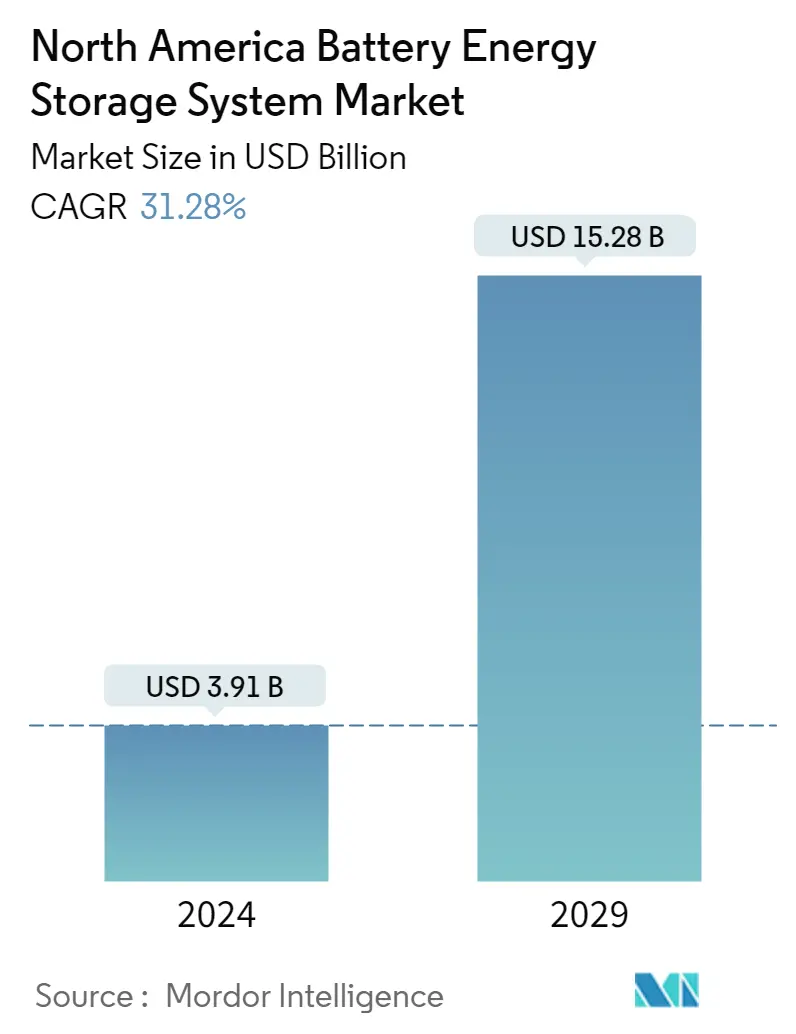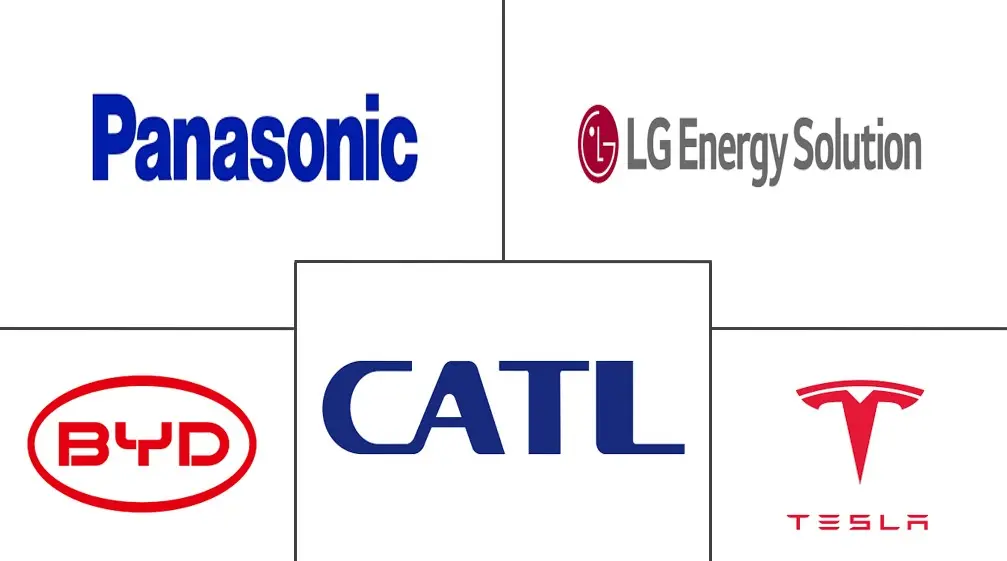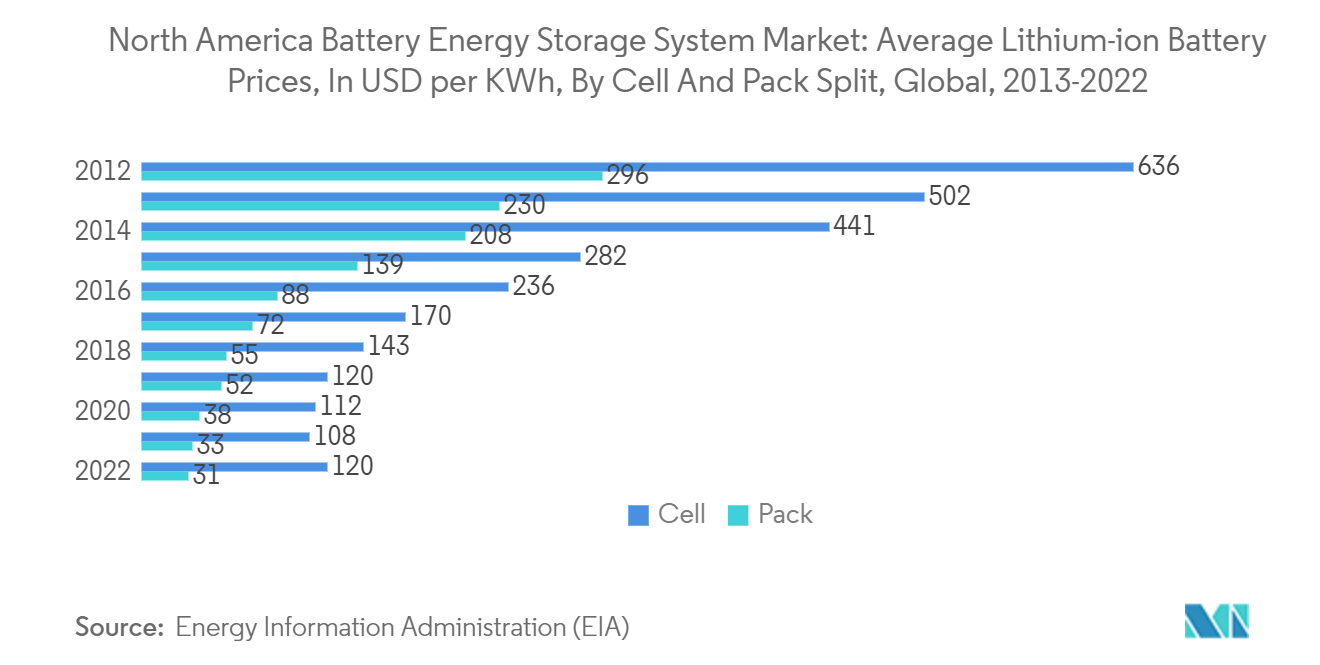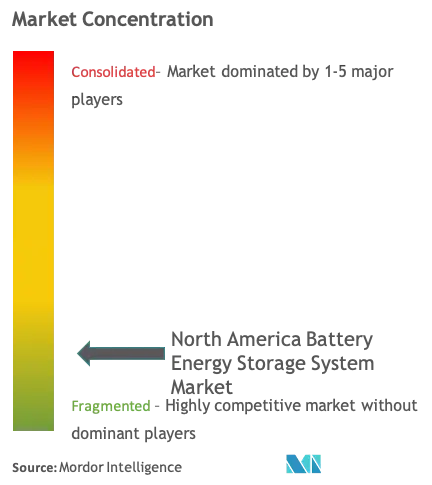North America Battery Energy Storage System Market Size

| Study Period | 2020 - 2029 |
| Base Year For Estimation | 2023 |
| Market Size (2024) | USD 3.91 Billion |
| Market Size (2029) | USD 15.28 Billion |
| CAGR (2024 - 2029) | 31.28 % |
| Market Concentration | Medium |
Major Players
*Disclaimer: Major Players sorted in no particular order |
North America Battery Energy Storage System Market Analysis
The North America Battery Energy Storage System Market size is estimated at USD 3.91 billion in 2024, and is expected to reach USD 15.28 billion by 2029, growing at a CAGR of 31.28% during the forecast period (2024-2029).
- Over the medium term, factors such as declining prices of lithium-ion batteries and increased penetration of renewable energy are likely to drive the North America battery energy storage systems market in the forecast period.
- On the other hand, other energy storage systems will likely hinder the growth of the North America battery energy storage systems (BESS) market in the studied period.
- Nevertheless, technological advancements in new battery technologies to store energy will likely create lucrative growth opportunities for the North America BESS market during the forecast period.
- The United States is the fastest-growing market during the forecast period due to the rising energy demand. This growth is attributed to increasing investments, coupled with supportive government policies in the country.
North America Battery Energy Storage System Market Trends
Lithium-Ion Battery Is Expected to Witness Significant Growth
- Lithium-ion (Li-ion) batteries are nearly 100% efficient in charge and discharge, allowing the same ampere-hours in and out. These batteries offer various technical advantages over other technologies, such as lead-acid batteries. Rechargeable Li-ion batteries, on an average, offer cycles more than 5,000 times, in comparison to lead-acid batteries that last for around 400-500 times.
- Li-ion batteries can be recharged numerous times and are more stable. Further, they tend to have a higher energy density, voltage capacity, and lower self-discharge rate than other rechargeable batteries. This improves power efficiency as a single cell has longer charge retention than different battery types.
- Additionally, Li-ion batteries do not need as frequent maintenance and replacement as the lead-acid batteries. Li-ion batteries maintain their voltage throughout the discharge cycle, allowing greater and longer-lasting efficiency of electrical components, whereas the voltage of lead-acid batteries drops consistently throughout the discharge cycle. Despite the higher upfront cost of Li-ion batteries, the true cost is much less than that of lead-acid batteries when considering lifespan and performance.
- Moreover, according to the Energy Information Administration (EIA), the average cost of lithium-ion batteries was recorded as USD 198 per kWh in 2018, which has declined by 23.7% compared to the price recorded as USD 151 per kWh in 2022. Also, it is expected that lithium-ion battery prices will face a gradual dip again from 2024, when lithium prices are expected to ease as more extraction and refining capacity comes online and reach USD 100/kWh by 2026.
- Further, the government of various countries in the region is developing the lithium-ion battery manufacturing infrastructure supporting the energy storage market. For instance, in June 2023, the United States Department of Energy’s Advanced Materials and Manufacturing Technologies Office (AMMTO) announced USD 2 million for the rejuvenation, recycling, and reuse of Lithium-ion battery programs administered through the ReCell Center located at Argonne National Laboratory (ANL).
- Similarly, many companies in the region are investing in lithium-ion battery technology. For instance, in January 2023, United States battery manufacturer Yoshino Technology announced the development of solid-state lithium-ion batteries with outputs ranging from 330 W - to 4,000 W designed for off-grid applications, home backup, and energizing small industrial machinery. The battery system can be used in combination with solar PV panels. The newly introduced 4,000 W power station has a peak power of 6,000 W and 2,611 Wh capacity. A 600 W solar panel can fully recharge in 5.5 hours.
- Therefore the growth in the energy storage is mainly expected to have a significant impact on the growth of lithium-ion battery market in the country during the forecast period.

The United States to Dominate the Market
- The battery energy storage system (BESS) in the United States has experienced significant changes in the past few years, especially in the residential and commercial sectors, supported by rising investments in renewable energy infrastructure.
- The rise in the adoption of solar PV systems by the residential, Commercial, and industrial (C&I) sectors is expected to be a substantial driver for the market studied. Government initiatives, such as net metering, have been one of the significant factors in adopting rooftop solar in the past few years.
- Further, in December 2022, The California Public Utilities Commission (CPUC) decided to discontinue new approvals of NEM 2.0 on 13 April 2023, replacing it with NEM 3.0, which only offers wholesale credits for their excess energy. NEM 2.0 and NEM 1.0 customers are expected to continue enjoying their benefits for 20 years from activation. Thus, this initiative will also positively impact during the forecast period.
- In the United States, most energy storage for residential, Commercial, and industrial (C&I) applications uses battery storage systems. Other energy storage systems include thermal and mechanical energy storage. Small-scale battery storage is a significant part of developing energy storage in the United States. Small-scale battery storage is at facilities with less than 1 MW of generating capacity.
- As of 2022, the cumulative large-scale battery storage capacity was around 22,385.1 megawatt-hours (MWh), which was approximately 80% percent more than in 2021, as per the United States Energy Information Administration.
- In the United States, the California Independent System Operator (CAISO) and Electric Reliability Council of Texas (ERCOT) have most of the large-scale battery storage capacity additions. In 2022, CAISO had 7561.3 MWh or 34 % share, and ERCOT had 1684.4 MWh capacity or 7.5% share in the country’s overall installed capacity.
- Therefore, considering the abovementioned factors, the battery energy storage systems market is expected to witness considerable progress in the upcoming years.

North America Battery Energy Storage System Industry Overview
The North America battery energy storage system market is moderately fragmented. Some key players in this market (in particular order) include BYD Company Limited, LG Energy Solution Ltd., Contemporary Amperex Technology Co. Ltd, Tesla Inc., and Panasonic Corporation.
North America Battery Energy Storage System Market Leaders
-
BYD Company Limited
-
Contemporary Amperex Technology Co. Ltd
-
Panasonic Corporation
-
Tesla Inc.
-
LG Energy Solution Ltd.
*Disclaimer: Major Players sorted in no particular order

North America Battery Energy Storage System Market News
- July 2023: EVLO Energy, a provider of battery energy storage systems & solutions and a subsidiary of Hydro-Quebec, announced its inaugural utility-scale storage venture in the United States. Positioned in Troy, Vermont, the 3MW/12MWh battery energy storage system initiatives are set to enhance the assimilation of indigenous renewables generation into the New England grid. Slated for operation by the end of 2023, EVLO is expected to oversee and uphold the system’s functionality for 20 years.
- June 2023: a collaborative effort between Ameresco and Atura Power is set to construct a battery energy storage system with a capacity of 250 MW and an energy storage capacity of 1 giga-watt hour. This endeavor is in response to a partnership with Canada's Independent Electricity System Operator. The joint venture is expected to oversee the project’s completion. The initiative is bound by a 20-year capacity agreement with the Independent Electricity System operator, securing its role in delivering energy storage services. Moreover, the project will encompass awarded backlog work exceeding USD 40 million.
North America Battery Energy Storage SystemMarket Report - Table of Contents
1. INTRODUCTION
- 1.1 Scope of the Study
- 1.2 Market Definition
- 1.3 Study Assumptions
2. RESEARCH METHODOLOGY
3. EXECUTIVE SUMMARY
4. MARKET OVERVIEW
- 4.1 Introduction
- 4.2 Market Size and Demand Forecast in USD, till 2028
- 4.3 Recent Trends and Developments
- 4.4 Government Policies and Regulations
-
4.5 Market Dynamics
- 4.5.1 Drivers
- 4.5.1.1 INCREASE IN ADOPTION OF RENEWABLE ENERGY
- 4.5.1.2 DECLINING COST OF LITHIUM-ION BATTERIES
- 4.5.2 Restraints
- 4.5.2.1 PRESENCE OF OTHER ENERGY STORAGE SYSTEMS
- 4.6 Supply Chain Analysis
-
4.7 Porter's Five Forces Analysis
- 4.7.1 Bargaining Power of Suppliers
- 4.7.2 Bargaining Power of Consumers
- 4.7.3 Threat of New Entrants
- 4.7.4 Threat of Substitutes Products and Services
- 4.7.5 Intensity of Competitive Rivalry
5. MARKET SEGMENTATION
-
5.1 Technology Type
- 5.1.1 Lithium-ion Batteries
- 5.1.2 Lead-Acid Batteries
- 5.1.3 Other technology types
-
5.2 Application
- 5.2.1 Residential
- 5.2.2 Commercial & Industrial
- 5.2.3 Utility
-
5.3 Geography
- 5.3.1 United States
- 5.3.2 Canada
- 5.3.3 Rest of North America
6. COMPETITIVE LANDSCAPE
- 6.1 Mergers and Acquisitions, Joint Ventures, Collaborations, and Agreements
- 6.2 Strategies Adopted by Leading Players
-
6.3 Company Profiles
- 6.3.1 BYD Company Limited
- 6.3.2 Saft America Inc
- 6.3.3 Contemporary Amperex Technology Co. Ltd
- 6.3.4 Tesla Inc.
- 6.3.5 LG Energy Solution Ltd.
- 6.3.6 Samsung SDI Co Ltd
- 6.3.7 Panasonic Corporation
- 6.3.8 Sunverge Energy LLC
- 6.3.9 AES Corporation
- *List Not Exhaustive
7. MARKET OPPORTUNITIES AND FUTURE TRENDS
- 7.1 DEVELOPMENT OF NEW ADVANCED BATTERY CHEMISTRIES
North America Battery Energy Storage System Industry Segmentation
A battery energy storage system is an electrochemical device that can convert electrical energy to chemical energy or vice-versa, depending on the usage. It is a technology that uses different battery chemistries to store energy generated from power sources.
The North America battery energy storage system market is segmented into type, application, and geography. By technology type, the market is segmented into lithium-ion batteries, lead-acid batteries, and other types. By application, the market is segmented into residential, commercial & industrial, and utility. The report also covers the market size and forecasts for the battery energy storage system market across major countries. The market sizing and forecasts for each segment are based on revenue (USD).
| Technology Type | Lithium-ion Batteries |
| Lead-Acid Batteries | |
| Other technology types | |
| Application | Residential |
| Commercial & Industrial | |
| Utility | |
| Geography | United States |
| Canada | |
| Rest of North America |
North America Battery Energy Storage SystemMarket Research FAQs
How big is the North America Battery Energy Storage System Market?
The North America Battery Energy Storage System Market size is expected to reach USD 3.91 billion in 2024 and grow at a CAGR of 31.28% to reach USD 15.28 billion by 2029.
What is the current North America Battery Energy Storage System Market size?
In 2024, the North America Battery Energy Storage System Market size is expected to reach USD 3.91 billion.
Who are the key players in North America Battery Energy Storage System Market?
BYD Company Limited, Contemporary Amperex Technology Co. Ltd, Panasonic Corporation, Tesla Inc. and LG Energy Solution Ltd. are the major companies operating in the North America Battery Energy Storage System Market.
What years does this North America Battery Energy Storage System Market cover, and what was the market size in 2023?
In 2023, the North America Battery Energy Storage System Market size was estimated at USD 2.98 billion. The report covers the North America Battery Energy Storage System Market historical market size for years: 2020, 2021, 2022 and 2023. The report also forecasts the North America Battery Energy Storage System Market size for years: 2024, 2025, 2026, 2027, 2028 and 2029.
North America Battery Energy Storage SystemIndustry Report
Statistics for the 2024 North America Battery Energy Storage System market share, size and revenue growth rate, created by Mordor Intelligence™ Industry Reports. North America Battery Energy Storage System analysis includes a market forecast outlook to for 2024 to 2029 and historical overview. Get a sample of this industry analysis as a free report PDF download.



